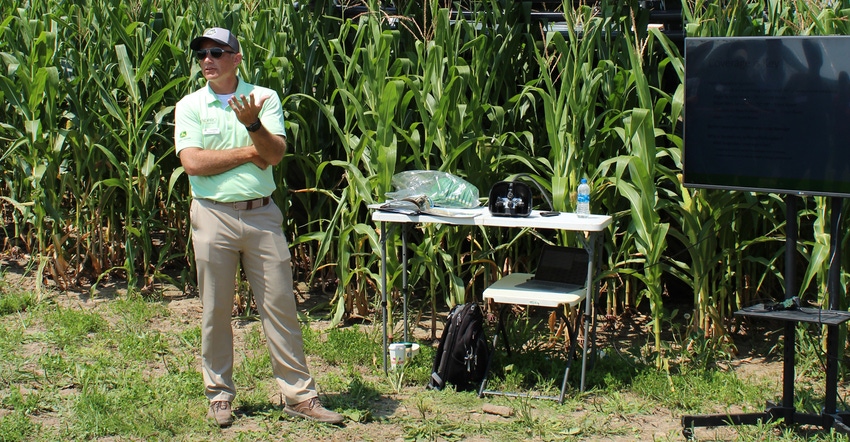August 18, 2021

Fungal blights can decimate corn yields. However, fungicide is only as helpful as how it’s applied.
And doing it late in the season raises its own questions since you don’t want to damage your corn.
“You wonder if you’re causing damage going in. Do you get a yield bump?” said Tom Sutter of LandPro Equipment, speaking to a group of growers at the New York Corn and Soybean Growers Summer Crop Tour at Catalpa Farms in Canandaigua.
Standing in front of a backdrop of towering corn, Sutter said that farmers may wonder if it’s even worthwhile to use a fungicide when fungal blight is at a low level.
A farmer may also wonder if fungal diseases would even happen without spraying.
Chris Flansburg, also of LandPro, added, “I’m not saying we don’t have foliar disease. In the Midwest, they’re corn on corn, and the inoculant is always there.”
Although a crop rotation of corn and soybeans is popular with some farmers, especially for its ability to improve soil health, it also means that residue from previous fungal application is diminished.
While a cool, wet spring creates a favorable environment for corn diseases to develop, drought conditions, as many are experiencing now, can also contribute to plant susceptibility to disease as the plant’s lack of nutrients stresses it.
“That brings the plant’s self-protection mechanism down,” Flansburg said.
Good timing and coverage
Effective application of fungicide is all about timing and coverage. The best time to apply is once tassels appear, but before the silk turns brown.
“Once you have brown silk, it might be a little late,” Flansburg said.
Proper coverage is also important when preventing blight. Overhead sprayers set at the correct height can help ensure coverage is ideal without damaging the stalks. Some sprayers can go as high as 78 inches.
“We don’t want to cause the least bit of damage,” Sutter said.
Flansburg added that farmers should also pay attention to droplet size and placement while spraying. The fungicide’s label indicates what to do.
“Time of day is important,” he added. “That 8 a.m. window takes advantage of dew to take spray a little farther. Systems can vary the rate throughout the field. You can load the prescription and apply where you will get benefits.”
GPS-controlled systems can help farmers pinpoint exactly where their corn requires more spray and avoid applying it where it will not offer as much benefit, such as areas with lower plant density.
Flansburg also encouraged attendees to select the correct carrier and nozzle based upon the label.
“Some data says to apply at 10 mph at 11 feet,” he said. “How droplets enter is a little more aggressive. Normal spraying speed is 12 to 14 mph. If you’re seeing insect pressure, get out there.”
About the Author(s)
You May Also Like




